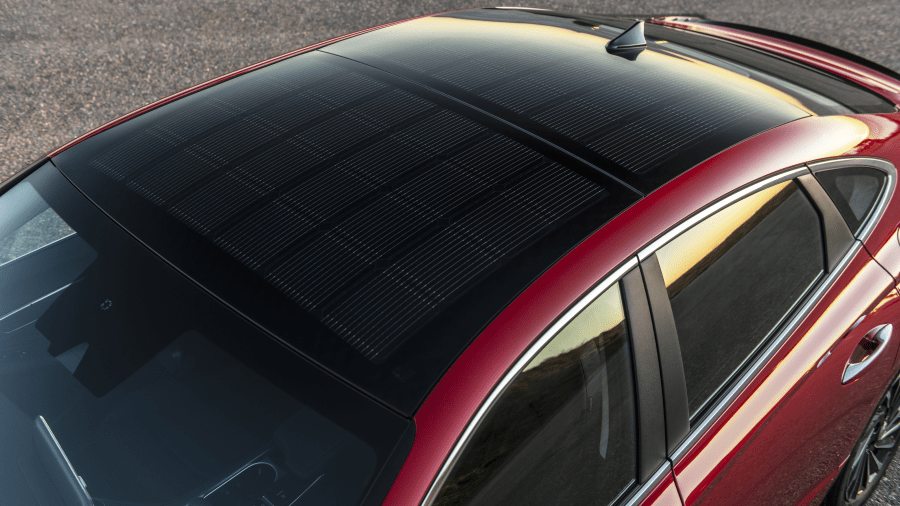Solar-powered cars are here, but there’s a long road to wide use

The dream of solar cars has been around for decades. In recent years, as solar technology has improved exponentially, what was once a novelty is now becoming a reality. Several automakers have plans to develop and refine solar-powered vehicles.
But how does solar deliver on the promise of a completely free and clean source of transportation power? We spoke with Sam Abuelsamid, an analyst with Guidehouse Insights.
He said one thing that’s changed is what we picture when we think of solar cars. It used to be they were mainly the experimental projects of engineering students. The following is an edited transcript of our conversation.
Sam Abuelsamid: So what you’re talking about are some of these experimental cars that have participated in various solar challenges. Over the years, many of these races have been run in places like Australia, across the Outback. So you’ve got these really skinny, flat vehicles that are running, and they’re very lightweight. They’ve got tiny, skinny little wheels, and they find the smallest student they can to drive the thing to minimize the weight. Not real practical for real-work use. The cars that we’re talking about today, like the Sonata Hybrid and also the new Fisker Ocean electric SUV, have optional solar roofs — it doesn’t look any different from any other any other vehicle. I mean, it just happens [that] if you look down at the roof, you can see the pattern, the photovoltaic cells on there. So that’s the only thing that is the distinguishing mark.

Jed Kim: When will the regular person in middle of America start seeing these?
Abuelsamid: I mean, they’re out there today. As I said, you can go to a Hyundai dealer today and buy a Sonata Hybrid with a solar roof option. Another thing where it actually also makes a lot of sense on EVs — for an electric vehicle, when you use either the heating or the air conditioning system, it’s drawing power directly from the battery, and that’s reducing your range. So if you’ve got an EV that you are parking outside, then if you have a solar panel on the car that can keep the cabin a little bit warmer while it’s sitting there, that means you’re going to have less reduction in range during cold-weather driving. Similarly, in hot weather, and again, you’re going to have better electric driving range on a charge.
Kim: Are consumers going to have to be convinced that this is a good idea? Or is this pretty obvious?
Abuelsamid: Near term, depending on what the option cost is, then yeah, they’ll probably have to be convinced. Is it worth me spending $2,000 or $3,000 or $5,000 for this solar roof option if I’m only going to get [an extra] mile or two a day [in range]? But as the price comes down, then I think it will eventually become a no-brainer. You know, it’s not like you’re gonna be able to just drive an EV all the time without ever plugging it in, right? That’s the part that you’ll have to convince people. But longer term, as those costs come down, then it becomes less of a challenge.
Kim: How much funding is going into making these kinds of cars?
Abuelsamid: Not a lot. It’s not a huge priority, I think, for most automakers right now, or at least, it hasn’t been. But I think as the costs come down, it will become something that most automakers will probably offer as an option, at least on most, if not all of their EVs going forward. Most of the effort on the part of the automakers has been focused on improving the batteries, improving the motor efficiency and the power electronics. So those are the low-hanging fruit for EVs. As they use up that low-hanging fruit, then they’ll be looking at other areas to improve efficiency and range of EVs.
Kim: Are we looking at the potential for solar technology to advance so far that we could have cars that get the vast majority of their energy from the sun?
Abuelsamid: Probably not, because you also have to keep in mind how much surface area you have on the roof of a car. It’s not that big an area, at best about the equivalent of one typical rooftop solar panel is about what you’ve got. And most people that have solar on their roof might have a couple of dozen panels. So it’s pretty limited just because of the physical dimensions of a car. Unless you’re driving something really enormous. Now, where it could get interesting is on trucks, tractor-trailers. You can put a lot of solar panels on the roof of that trailer. And it’s a flat surface. It’s not necessarily tilted at the right angle, but it’s probably better than most cars. And so, if you’re talking about electric trucks, now you’re actually starting to get something interesting there. Or delivery vans. Amazon is going to get 100,000 electric delivery vans from Rivian over the next several years, and if you put solar panels on the roof of all those things, you know, those are pretty big vans. That could actually make a difference.
Related Links: More insight from Jed Kim
My first impression of solar cars was seeing one in a magazine. It was a car built by University of Michigan students. After talking with Sam, I looked that car up again. It’s name was Sunrunner, and it was built in 1990. Here is a link to the engineering report put together by the students. It’s pretty cool to see earlier stages of solar car tech. Check it out.
Every couple years, there is a solar car race that takes place in Australia. The Bridgestone World Solar Challenge is a roughly 2,000 mile drive across the Outback from Darwin to Adelaide. Competitors run solely on solar power — there are batteries on board that the solar panels charge. There’s a surprisingly watchable series on YouTube about it. Things get pretty hairy from the first episode.
The future of this podcast starts with you.
Every day, the “Marketplace Tech” team demystifies the digital economy with stories that explore more than just Big Tech. We’re committed to covering topics that matter to you and the world around us, diving deep into how technology intersects with climate change, inequity, and disinformation.
As part of a nonprofit newsroom, we’re counting on listeners like you to keep this public service paywall-free and available to all.
Support “Marketplace Tech” in any amount today and become a partner in our mission.


















